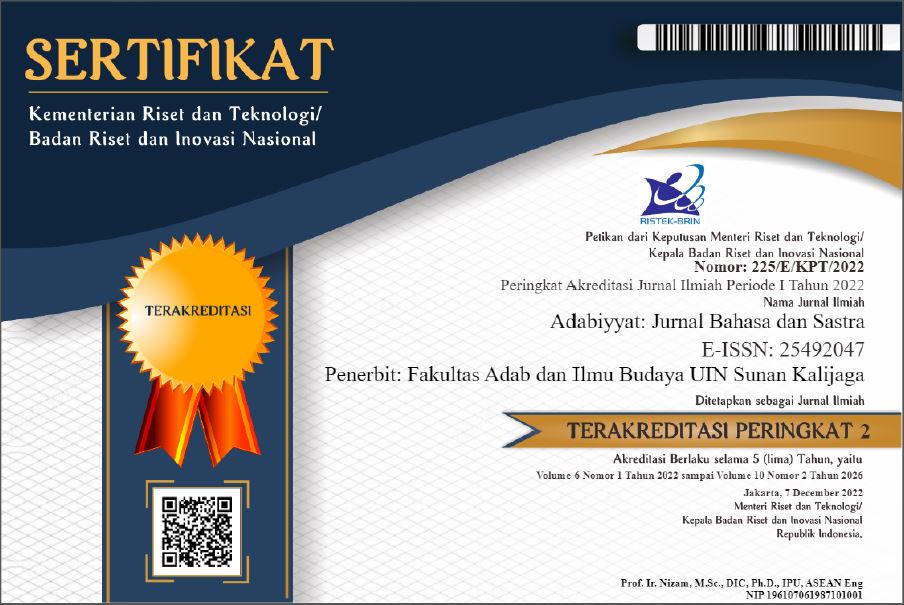SOCIAL IDENTITY CONSTRUCTION OF THE DISABLED IN FORREST GUMP NOVEL
DOI:
https://doi.org/10.14421/ajbs.2024.080106Keywords:
the disabled, identity, society, strategyAbstract
Superintelligence plays an important role in the development of discourse about posthumanism. In this context, the researcher discussed posthumanism studies in the movie M3GAN (2022). The study focused on the moral status of artificial intelligence embodied robotic prototypes created by humans, namely M3GAN. In other words, how can the protocol system be implemented on M3GAN? Does M3GAN possess moral status regarding suffering, pain, autonomy, interactivity, and adaptivity? How did the humans reveal and interact with this technology in the posthumanism era as depicted in the movie? This article used the posthumanism theory from Robert Pepperell to analyze and answer the research questions. The study used descriptive qualitative data from the dialogue scenes and visual screenshots to represent the analysis results. The results of this research show that artificial intelligence in the form of the M3GAN prototype has moral status, such as autonomy, interactivity, and suffering. It becomes a dystopian reality for the robotic creator. Furthermore, the ethics of artificial intelligence or superintelligence must be unveiled wisely in the implementation.
Downloads
References
Alshammari, Sultan Hammad. 2018. “The Relationship Between Language, Identity and Cultural Differences: A Critical Review.” Research on Humanities and Social Sciences 8 (4): 98.
Groom, Winston. 1986. Forrest Gump. Ed. 1. New York: Doubleday.
Hall, Melinda C. 2019. “Critical Disability Theory.” In The Stanford Encyclopedia of Philosophy, edited by Edward N. Zalta. Stanford: Metaphysics Research Lab, Stanford University. https://plato.stanford.edu/archives/win2019/entries/disability-critical/.
Harris, Sarah Parker, Rob Gould, and Courtney Mullin. 2019. “Experience of Discrimination and the ADA.” Chicago: Department of Disability and Human Development University of Illinois at Chicago.
Hopson, Jericha. 2019. “Disability as Culture.” Multicultural Education 27 (1): 22–24.
Joseph, John E. 2012. “Cultural Identity.” In The Encyclopedia of Applied Linguistics. New Jersey: Wiley-Blackwell. https://doi.org/10.1002/9781405198431.
Lejzerowicz, Magda. 2017. “Identity and Its Reconstruction and Disabled People.” International Journal on Disability and Human Development 16 (1): 19–24. https://doi.org/10.1515/ijdhd-2016-0036.
Mambrol, Nasrullah. 2016. “Postmodernism.” Literary Theory and Criticism. March 31, 2016. https://literariness.org/2016/03/31/postmodernism/.
Nair, Ninu. 2020. “Forrest Gump: Comparing the Book and Its Movie Adaptation.” Bookishloom (blog). January 17, 2020. https://bookishloom.wordpress.com/2020/01/17/forrest-gump-a-review-of-this-iconic-movie-and-the-book-in-one-box/.
Putri, Anita, and Paulus Sarwoto. 2016. “Saussurian Binary Opposition as the Narrative Structure of Williams Summer and Smoke.” Journal of Language and Literature 16 (1): 82–98. https://doi.org/10.24071/joll.v16i1.154.
Schneck, Gina. 2015. “The Blind Can See: Revisiting Disability in Jane Eyre.” Criterion: A Jurnal of Literary Criticism 8 (2): 80–87.
Downloads
Published
Issue
Section
License
Copyright (c) 2024 Bambang Margo Susanto

This work is licensed under a Creative Commons Attribution-ShareAlike 4.0 International License.
- Adabiyyāt: Jurnal Bahasa dan Sastra publishes all articles entirely in full text.
- It is permissible for readers to download and to use it for scientific purposes and scientific dissemination.
- The author can re-publish the article that has been published by the Adabiyyāt: Jurnal Bahasa dan Sastra after obtaining written permission from the editor. This letter can be obtained by submitting a request letter for permission to republish the article to Adabiyyāt: Jurnal Bahasa dan Sastra via email adabiyyat@uin-suka.ac.id. In the second publication, the author is required to include information that the article was firstly published by the Adabiyyāt: Jurnal Bahasa dan Sastra.



















